Beneteau First 53
A gentleman’s racing yacht
By Zuzana Prochazka
With 24,000 boats produced in nearly 40 years, French builder Groupe Beneteau is reinventing their First range, which was introduced in 1977. Although the four other models in the current First lineup are under 30 feet, Beneteau dispensed with two-footitis and jumped right up to a yacht that’s 56’3” LOA. With the introduction of the Beneteau First 53, they’ve dispensed with the concept of barebones racing hulls and launched what they refer to as “luxury performance” sailing.
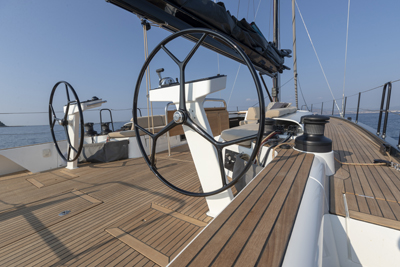 Harken Performa winches do the heavy lifting.
Harken Performa winches do the heavy lifting.
Design & Construction
The idea of the First 53 was mulled over for a long time. In fact, Beneteau launched a design competition in 2016 before finally choosing Roberto Biscontini as naval architect and Lorenzo Argento for exterior and interior design. Biscontini’s 30 years of America’s Cup experience created a balanced hull with a carefully positioned center of buoyancy. Meanwhile, Argento’s background with Wally Yachts created a modern and minimalist hull and deck with a plumb bow, nearly vertical transom, low coarchroof, open stern, a beam that is carried all the way aft and a clean cockpit. Argento didn’t miss a detail in his distinctive styling.
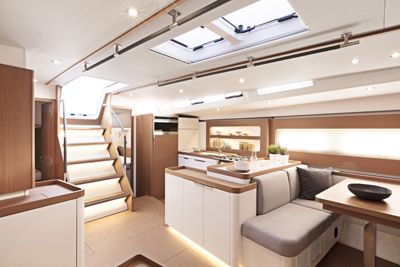 The galley has good bracing points so the chef can cook underway on either tack.
The galley has good bracing points so the chef can cook underway on either tack.
The hull is cored with balsa, which isn’t surprising, but that it’s cored all the way to the keel is somewhat unusual. Of course that makes the 53 stiff and contributes to the 20,000-pound weight savings over the slightly larger Beneteau Oceanis 62. Other reasons she’s lighter include an infused construction, smaller tankage, a light furniture build and even Dyneema lifelines.
The construction combines fiberglass stringers and interior fittings that are fixed to an aluminum substructure or sub-sole. This helps lower the overall center of gravity and optimizes performance. The choice of keel includes three options: shoal at 6’ 3”, standard at 8’ 2” and a deep version at 9’10”, which is what our test boat, hull #3 and the first one on this side of the Atlantic, had fitted.
Rigging
The deck-stepped tapered, triple-spreader Lorima mast towers 85 feet over the deck. Our test boat had the aluminum version with rod rigging but a carbon spar is available. The genoa furler is below deck, the tracks are recessed and all hatches are flush so the deck is so smooth you could go bowling. The sail plan is a massive 1,800 square feet between the genoa and the main, which are managed by Harken Performa electric winches.
The sheeting angles are tight and with the composite sprit, the rig is flexible, adding the ability to attach a Code 0 or a full spinnaker. Additional sail shape can be coaxed out of the North NPL laminate sails with the hydraulic vang and backstay.
Three boom shapes are available: standard Sparcarft, LeisureFurl in-boom furling and a wide V-boom that helps capture the large mainsail before it slides down onto the deck. The split mainsail track is a nice touch. It allows the cars to alternate when stacking, thereby cutting the height of the luff in half when the mainsail is down so you can reach the halyard more easily. With a rig and sail this size, it’s almost a must-have feature and it’s great thinking by Beneteau.
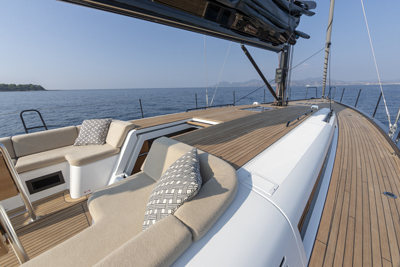 The view to the bow is a straight shot with little to get in the way.
The view to the bow is a straight shot with little to get in the way.
On Deck
It’s hard to know where to begin describing this sleek speedster. Her profile is imposing as if she was drawn specifically to intimidate on the racecourse. The cockpit, where teak is standard, is all on one level and the ultra-wide transom ensures there’s plenty of room for a full crew to work. Twin angled slim-line binnacles hold carbon wheels and superyacht-style dashboards with 12-inch B&G MFDs. Engine controls are at each station and on top of the binnacles rather than at knee level so docking is simplified regardless of the side of approach.
The social cockpit is well forward of the wheels, ensuring that those actively engaged in sailing need not disturb those not so actively engaged in lounging. Instead of a cockpit table that always seems to be an obstacle, there are twin smaller tables on either side, which opens up a path from the companionway all the way aft to the transom. The tables fold out to accommodate diners, but they also shrink up for cocktails or just to maximize space. The rails in between will be the safest place to stand when the boat is beating to windward.
From the cockpit, there’s only one step up onto the wide side decks. Our boat had the optional teak decks and the effect was one of being on a superyacht. There’s nothing on deck to catch a lazy sheet. Six wing pop-up cleats fold down neatly and the Lewmar windlass is mounted below deck. From the wheel, you can see all the way forward to the anchor roller. Because there’s no raised cabinhouse in the way, the deck feels elongated as if you’re driving a supertanker. The visibility is exceptional.
One thing that Beneteau never fails to add is a water fill next to the waste tank pump-out. It’s mindboggling that despite this being repeatedly pointed out, the two fills continue to be placed on deck within inches of one another.
A dinghy garage is tucked into the aft end of the hull and it’s accessible when the transom is lowered electrically. It will hold an eight-foot inflated tender or a nine-foot deflated one. Steps to starboard pop out automatically and then recess again with the transom up. To add to the serious racer aesthetic, B&G 20/20 instrument displays are mounted at the mast base where they’re visible from anywhere aft including from the swim platform.
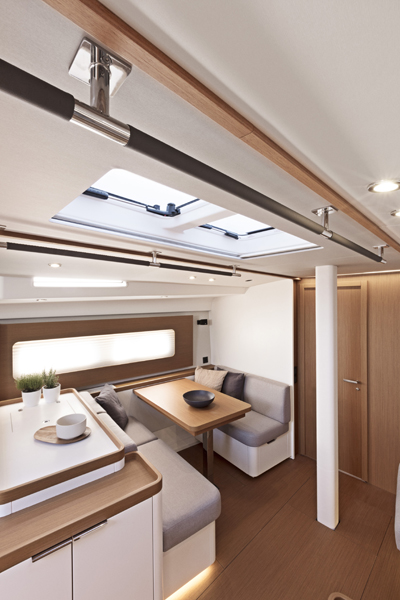 The dinette table and the seat on the forward bulkhead extend so six can dine at the same time.
The dinette table and the seat on the forward bulkhead extend so six can dine at the same time.
Contemporary Interior
Not surprisingly, the interior is open concept creating a feeling of space and light. A departure from most layouts in this class, the designer separated the dinette from the salon lounge. The dining booth is forward of the galley to port. The table and the forward seat extend so six can eat simultaneously. The U-shaped sofa opposite is perfect for relaxing and takes up most of the starboard side. This combination of furniture has the effect and comfort of a house rather than a vessel.
The galley is U-shaped and offers good bracing for those who will end up cooking under way. A two-burner stove, large single sink, a top-loading freezer and a full stand up refrigerator provide the chef with all the tools to put out great meals on a weekend cruise or during an offshore race. Fiddles do double duty to keep dishes from flying when heeling and also to act as handholds when moving forward or aft.
As on deck, the approach is minimalist with hidden functionality. Digital switching is by Scheiber and Beneteau adds their Ship Control system that allows control of certain systems via a tablet or smartphone. Combined, the two reduce the number of visible switches and controls throughout the interior.
There are two steps that interrupt an otherwise flat cabin sole. One step down is into the galley and the other is into the master stateroom, which is in the bow. Here you’ll find a large island berth, a split head and shower, an impressive amount of stowage space and plenty of light from the hull windows.
The standard layout includes three cabins and two heads. You can opt for a crew cabin with a bed, a head and a sink in the bow but North American owners will likely eschew the idea of a professional captain. That would take all the fun out of owning a boat like this so that forward space will likely be used for storage.
Beneteau is positioning the First 53 as a semi-custom build, which means you can opt to tinker with the interior and for example, add a navigation station, which in the standard version is notably missing. Other options include a Dometic bottle chiller, a dishwasher and a generator. The finish on our boat made ample use of white surfaces accented with teak. Courtesy lighting under furniture added a soft glow and every cubby seemed to be put to good use. A nice detail includes the use of magnetic doors which remove the latches on which you can catch clothing or cut your hand and that’s just one more testament to the attention to detail throughout the interior.
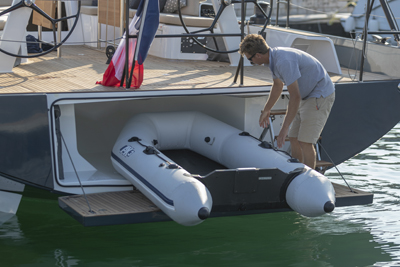 An eight-foot inflated dinghy will fit into the garage.
An eight-foot inflated dinghy will fit into the garage.
Under Sail
The First 53 is one of those boats you really want to take out and put to the test. Sadly, we were met with a light breeze on test day with occasional gusts to 10 knots. At 55 degrees apparent wind angle (AWA) in 8.7 knots of true wind, we glided along at 6.5 knots, which is remarkable. For certain, the 53 can point as she continued to carry 5.5 knots of boat speed all the way up to 35 degrees AWA. As the true breeze dropped below six knots and we fell off to a beam reach, we kept up a momentum of three knots. This is a boat that likes to go upwind and her beam of nearly 16.5 feet keeps her on her feet. It’ s just too bad we couldn’t have sailed her in conditions that would have shown off her true potential.
Under Power
Two options of propulsion are offered. The standard is a Yanmar 80 with Saildrive but our boat was fitted with the upgraded 110-hp turbo diesel with a straight shaft. With a Flexofold folding propeller, we motored at 9.6 knots and 3400 rpm at wide-open throttle. A more economical cruise can be found at 8.7 knots and 2200 rpm where the she burns about 1.5 gallons per hour. Our entire test was conducted on flat water so we had no confirmation of her performance in swells and chop and it’s hard to say whether she’d pound to weather or fishtail when surfing.
Despite her impressive dimensions, the Beneteau 53 is nimble in tight quarters thanks in part to the Sidepower bow thruster. A stern thruster is optional and both are retractable so nothing mars her performance under sail.
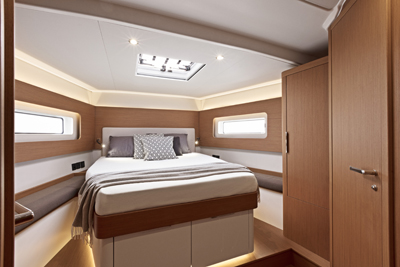 The master is bright and has copious amounts of storage space.
The master is bright and has copious amounts of storage space.
Overall Thoughts
The 53 is a big and showy effort to revive the First name. At $1.1 million as tested (or $1.25 million with everything including a carbon rig) she’s not for everyone but she does breathe new life into what has become known as a line of small racing boats. With this new model, Beneteau has definitely gotten everyone to take notice and regardless of what you call it – “high performance cruising” or “luxury racing”, the Beneteau 53 is purpose built for demanding owners. She has a specific set of skills, which expert sailors will appreciate, and a refined style that makes her a true gentleman’s racer.
Specifications
LOA: 56′ 3″
Beam: 16′ 5″
Draft: 6’3”, 8’ 2”, 9’10”
Displacement: 34,170 lbs.
Sail Area: 1,809 sq. ft.
Fuel/Water: 106/190 gallons
Engine: Yanmar 80 or110 HP w/ Saildrive
Designer: Biscontini Yacht Design
Builder: Groupe Beneteau
Base price: $750,000 USD
As tested price: $1,100,000 USD






















